Home / Alkene Addition Pattern #2: The “Three-Membered Ring” Pathway
Organic Chemistry Tips and Tricks
Alkene Addition Pattern #2: The “Three-Membered Ring” Pathway
Last updated: January 23rd, 2024 |
The “Three-Membered Ring” Pathway In Alkene Mechanisms: Halogenation, Oxymercuration, Halohydrin Formation, and Acidic Epoxide Opening
In the last post we walked through a proposal for how the bromination of alkenes works and showed that it adequately explains many of the experimental observations made for this reaction.
Namely, the reaction proceeds with anti addition of substituents across the alkene, and (where relevant) the reaction proceeds with “Markovnikov” regioselectivity. These observations are best explained through the intermediacy of a “bromonium ion”.
In this post we try to show that bromination is but one example of a whole family of reactions in introductory organic chemistry that pass through a positively charged three membered ring, including not just halogenation, but oxymercuration, halohydrin and haloether formation, and even addition to protonated epoxides.
Since all of these reactions follow the same pattern, if you learn any one of these mechanisms, you’ve essentially learned them all!
Table of Contents
- Bromination of Alkenes: The Mechanism
- Chlorination of Alkenes: Mechanism
- Iodination of Alkenes: Mechanism
- Chlorohydrin Formation: Mechanism
- Haloether Formation: Mechanism
- Chlorohydrin Formation With NBS: Mechanism
- Oxymercuration Of Alkenes: Mechanism
- Oxymercuration: The Reduction Step
- A Non-Obvious Cousin Of Halonium Ions: Protonated Epoxides
- Summary: The Key Pattern Of The “Three-Membered Ring Pathway”
- Notes
- (Advanced) References and Further Reading
1. Bromination of Alkenes: The Mechanism
This is just a review of what we saw in the previous post. Treating an alkene with Br2 results in a vicinal dibromide with the two bromines oriented anti to each other. The key intermediate is a “bromonium ion”, which contains a positively charged 3-membered ring.
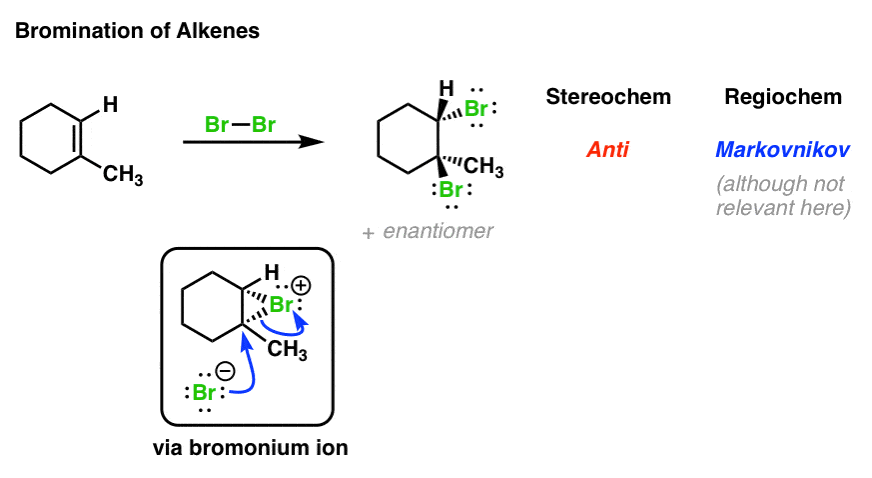
Taking bromination of alkenes as a starting point, we might ask: “do variants of this mechanism operate for other reactions of alkenes as well?”
The answer is yes!
2. Chlorination of Alkenes: The Mechanism
Take, for example, the chlorination of alkenes. The products of this reaction has identical patterns of stereoselectivity and regioselectivity to those of bromination. Therefore we might surmise that they proceed through the same type of reaction intermediate! [This intermediate is called the “chloronium ion”]
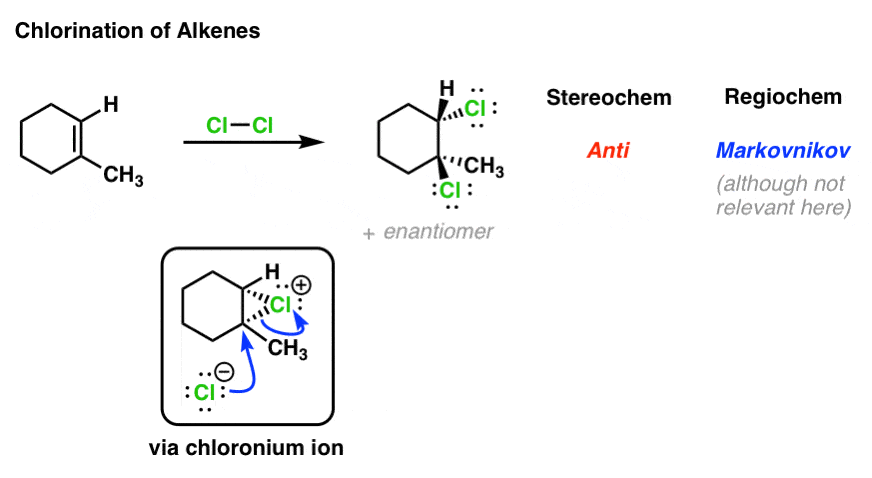
3. Iodination of Alkenes: The Mechanism
This is also the case for iodination reactions, which proceed through the “iodonium ion”:
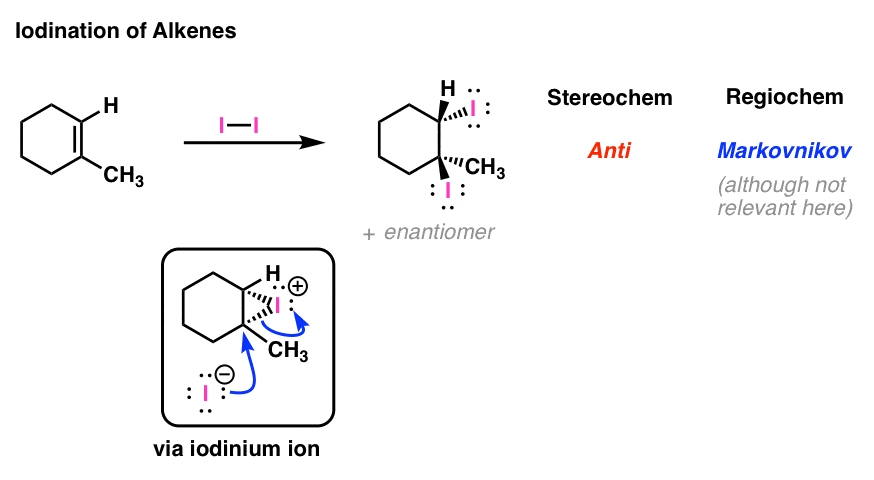
4. Chlorohydrin Formation: The Mechanism
This also applies to reactions where the intermediate chloronium ion is trapped with solvent (water in this case). After deprotonation of R–OH+ to give R–OH, the product is referred to as a “chlorohydrin”.
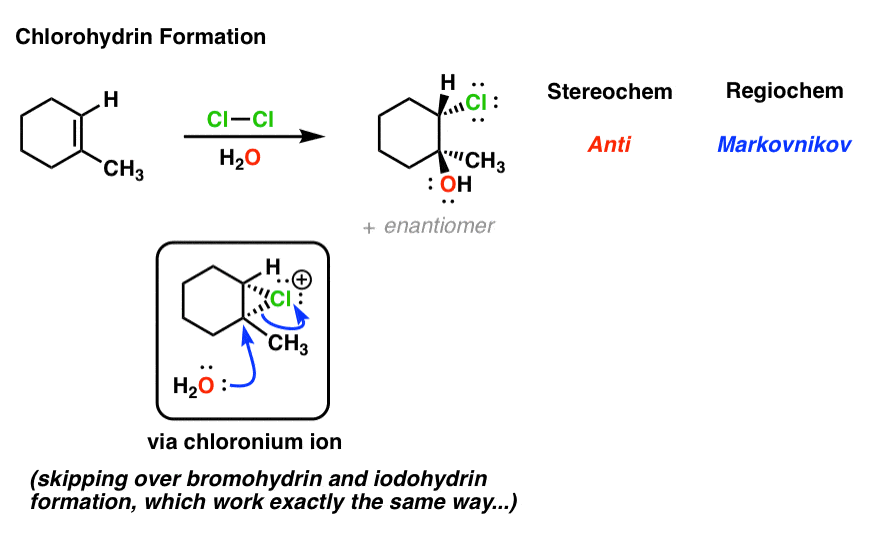
Note that bromohydrin and iodohydrin formation work exactly the same way and if you merely replace “Cl” with either of those halogen atoms you’ll obtain the indicated product.
5. “Haloether” Formation: The Mechanism
As described in the last few posts, what’s notable about bromination is that by using a solvent which can act as a nucleophile, we can obtain products which incorporate that solvent. For example by using an alcohol as solvent, we obtain the following “chloroetherification” product. It likewise proceeds through the exact same mechanism described above.
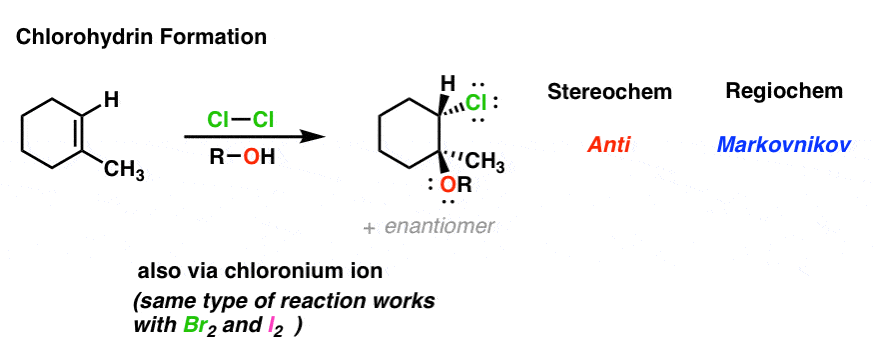
Furthermore, these reaction pathways are not confined to the dihalogens Cl2, Br2, and I2 [nor F2, the Tiger of Chemistry, which is a very difficult beast to keep on its leash]. And a good thing too, since Cl2 and Br2 are to various extents vile and inconvenient to work with.
6. Chlorohydrin Formation Using N-Chloro Succinimide
A convenient source of “electrophilic” chlorine is the crystalline salt N-chlorosuccinimide (NCS), an innocuous appearing white crystalline solid. Alkenes react rapidly with NCS to form chloronium ions, which can then be intercepted to form a variety of useful products by analogy to those shown above. With the exception of this more convenient source of halogen, the reaction is otherwise the same. N-bromosuccinimide (NBS) and N-iodosuccinimide (NIS) likewise find use.

Moving beyond the halogens, are there other reagents that form these cyclic intermediates? Why, yes indeed.
7. Oxymercuration: The Mechanism
When alkenes are treated with mercury (II) salts (such as mercuric acetate) in the presence of water or alcohols, we obtain products with the same pattern of stereochemistry and regiochemistry that we’re accustomed to seeing by now. What’s a likely intermediate here? A three-membered ring called the “mercurinium ion”.
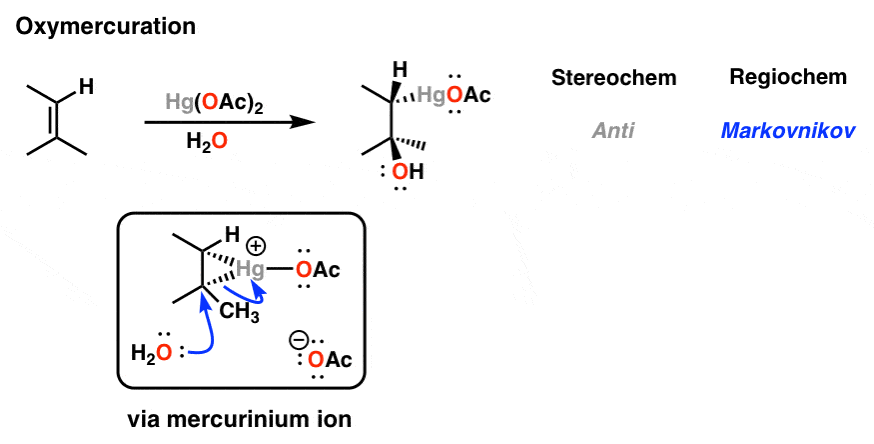
8. Oxymercuration: The Reduction Step
Organomercury compounds find very little application in themselves, but can be used as intermediates in subsequent reactions. To replace mercury with hydrogen, sodium borohydride (NaBH4) is added. In this case, rather than being “anti” , the stereochemistry of this reaction ends up being a wash: treatment with NaBH4 leads to cleavage of the C-Hg bond and formation of a free radical. The free radical can react from either face with hydrogen, leading to scrambling of the stereocenter.
To see a plausible mechanism, hover here or click this link.
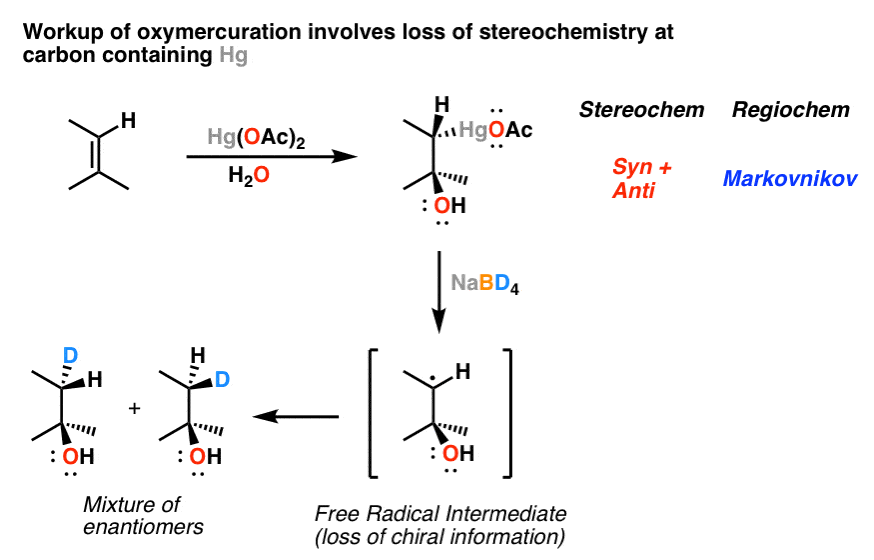
How many other reactions go through this type of mechanism? There is actually a sizable list. For instance, there are electrophilic sources of sulfur and selenium that can likewise form three membered cationic rings just like those we’ve seen; we won’t go into those.
9. A Non-Obvious Cousin: Protonated Epoxides
One last example that is worth going into is one that might not immediately seem obvious: protonated epoxides.
Treatment of an epoxide with acid leads to a positively charged intermediate that resembles a bromonium ion. As you might guess, the nucleophile attacks the backside of the most substituted carbon and the resulting product has anti stereochemistry. Just as we’ve seen numerous times above.
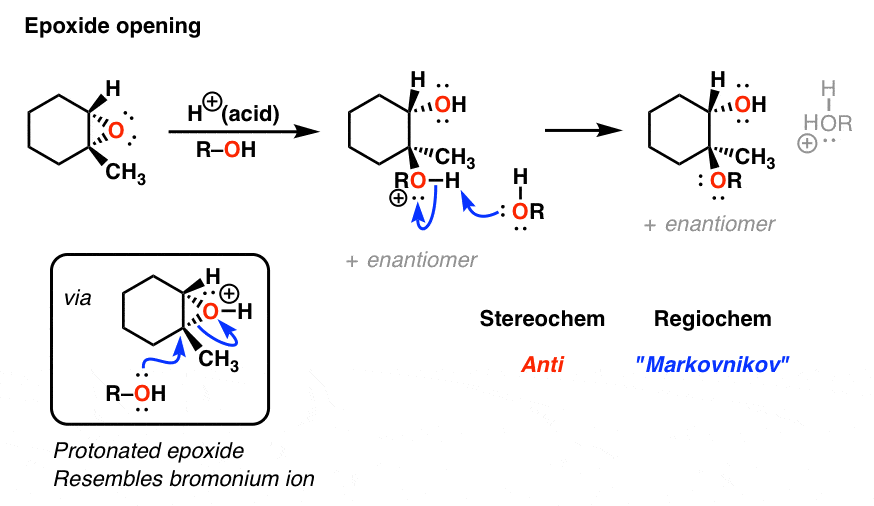
10. Summary: The Key Pattern Of The “Three-Membered Ring Pathway”
Do some of the images in this post look repetitive? They should!
The lesson for this very long post from today is that one can group together a sizable number of different reactions by identifying their common mechanism. Just as there is a family of reactions that pass through the carbocation pathway, there is likewise a “family” of reactions that pass through a three-membered ring. Instead of learning a dozen different mechanisms, we merely learn one – and merely change the actors to suit the occasion.
NEXT POST – Hydroboration of Alkenes
Notes
Related Articles
- Hydroboration – Oxidation of Alkenes
- Hydroboration Oxidation of Alkenes Mechanism
- Alkene Addition Pattern #3: The “Concerted” Pathway
- Alkene Addition Pattern #2: The “Three-Membered Ring” Pathway
- Addition Pattern #1: The “Carbocation Pathway”
- Alkene Reactions Practice Problems (MOC Membership)
- Oxymercuration Demercuration of Alkenes
- Halogenation of Alkenes and Halohydrin Formation
Note 1. Besides the dihalides, there are also such things as mixed dihalides, such as iodine monochloride. We have all the tools at our disposal to answer how this reaction might proceed. What do you think the product is?
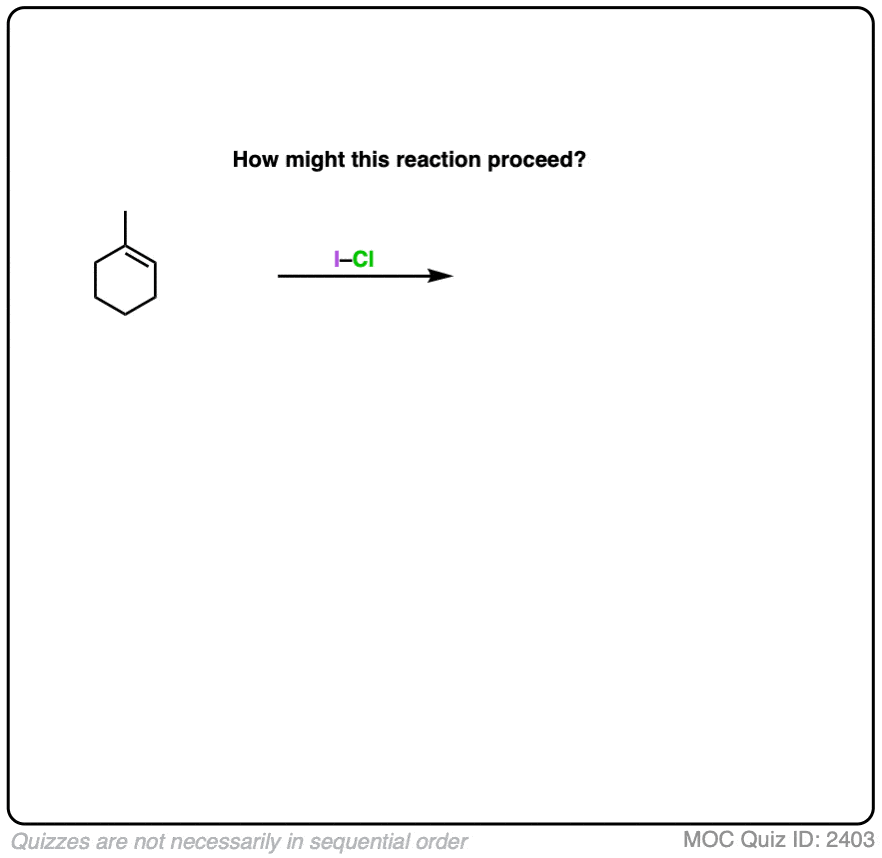 Click to Flip
Click to Flip
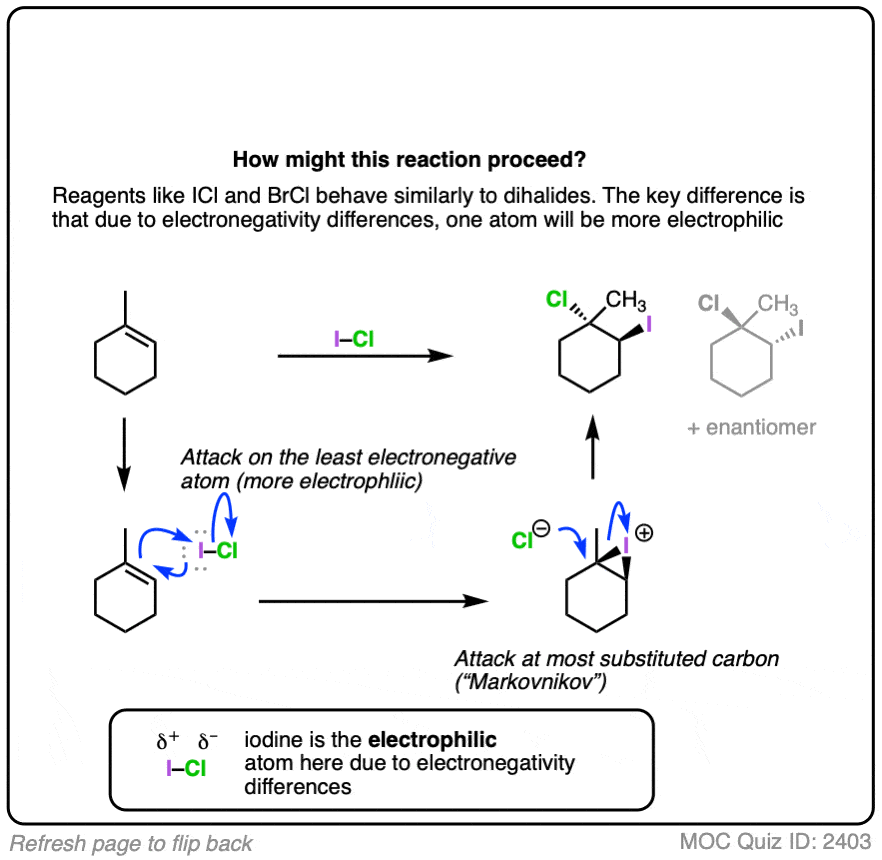
(Advanced) References and Further Reading
This is a common mechanism for several reactions, including halogenation, halohydrin formation, and oxymercuration.
Halogenation:
- The Halogenation of Ethylenes
Irving Roberts and George E. Kimball
Journal of the American Chemical Society 1937, 59 (5), 947-948
DOI: 1021/ja01284a507
One of the earliest descriptions in the literature of a three-membered bromonium ion, accounting for the anti stereochemistry of this reaction. - Stable carbonium ions. LXII. Halonium ion formation via neighboring halogen participation: ethylenehalonium, propylenehalonium, and 1,2-dimethylethylenehalonium ions
George A. Olah, J. Martin Bollinger, and Jean Brinich
Journal of the American Chemical Society 1968, 90 (10), 2587-2594
DOI: 1021/ja01012a025
This is an early paper on the characterization by NMR of halonium (3-membered chloronium, iodonium, and bromonium) ions by ionization of 1,2-dihaloethanes in superacid medium (SbF5/SO2). - Investigation of the Early Steps in Electrophilic Bromination through the Study of the Reaction with Sterically Encumbered Olefins
R. S. Brown
Accounts of Chemical Research 1997, 30 (3), 131-137
DOI: 10.1021/ar960088e
An account by R. S. Brown describing the research he carried out in interrogating bromonium ion intermediates by a variety of methods.Mercuration: - Mechanism of the oxymercuration of substituted cyclohexenes
Daniel J. Pasto and John A. Gontarz
Journal of the American Chemical Society 1971, 93 (25), 6902-6908
DOI: 1021/ja00754a035
This paper demonstrates that “the oxymercuration of substituted cyclohexenes proceeds via mercurinium ion intermediates which are formed in fast, reversible pre-rate-determining step equilibria”. - Organometallic chemistry. IV. Stable mercurinium ions
George A. Olah and Paul R. Clifford
Journal of the American Chemical Society 1973, 95 (18), 6067-6072
DOI: 1021/ja00799a038
The above paper by Nobel Laureate Prof. G. A. Olah demonstrates the existence and intermediacy of mercurinium ions in these reactions via the s and p routes using NMR spectroscopy. - Solvomercuration-demercuration. 11. Alkoxymercuration-demercuration of representative alkenes in alcohol solvents with the mercuric salts acetate, trifluoroacetate, nitrate, and methanesulfonate
Herbert C. Brown, Joseph T. Kurek, Min Hon Rei, and Kerry L. Thompson
The Journal of Organic Chemistry 1984, 49 (14), 2551-2557
DOI: 1021/jo00188a007
While Hg(OAc)2 is the most commonly used reagent for this purpose, the trifluoroacetate, trifluoromethanesulfonate (triflate), or nitrate salts are more reactive and may be preferable for certain applications. - Mechanism of reduction of alkylmercuric halides by metal hydrides
George M. Whitesides and Joseph San Filippo Jr.
Journal of the American Chemical Society 1970, 92 (22), 6611-6624
DOI: 1021/ja00725a039
The reduction (demercuration) step is complex and involves free radicals. This paper by Prof. Whitesides (MIT, now at Harvard) studies the mechanism of this reduction, which is mentioned inside.
00 General Chemistry Review
01 Bonding, Structure, and Resonance
- How Do We Know Methane (CH4) Is Tetrahedral?
- Hybrid Orbitals and Hybridization
- How To Determine Hybridization: A Shortcut
- Orbital Hybridization And Bond Strengths
- Sigma bonds come in six varieties: Pi bonds come in one
- A Key Skill: How to Calculate Formal Charge
- The Four Intermolecular Forces and How They Affect Boiling Points
- 3 Trends That Affect Boiling Points
- How To Use Electronegativity To Determine Electron Density (and why NOT to trust formal charge)
- Introduction to Resonance
- How To Use Curved Arrows To Interchange Resonance Forms
- Evaluating Resonance Forms (1) - The Rule of Least Charges
- How To Find The Best Resonance Structure By Applying Electronegativity
- Evaluating Resonance Structures With Negative Charges
- Evaluating Resonance Structures With Positive Charge
- Exploring Resonance: Pi-Donation
- Exploring Resonance: Pi-acceptors
- In Summary: Evaluating Resonance Structures
- Drawing Resonance Structures: 3 Common Mistakes To Avoid
- How to apply electronegativity and resonance to understand reactivity
- Bond Hybridization Practice
- Structure and Bonding Practice Quizzes
- Resonance Structures Practice
02 Acid Base Reactions
- Introduction to Acid-Base Reactions
- Acid Base Reactions In Organic Chemistry
- The Stronger The Acid, The Weaker The Conjugate Base
- Walkthrough of Acid-Base Reactions (3) - Acidity Trends
- Five Key Factors That Influence Acidity
- Acid-Base Reactions: Introducing Ka and pKa
- How to Use a pKa Table
- The pKa Table Is Your Friend
- A Handy Rule of Thumb for Acid-Base Reactions
- Acid Base Reactions Are Fast
- pKa Values Span 60 Orders Of Magnitude
- How Protonation and Deprotonation Affect Reactivity
- Acid Base Practice Problems
03 Alkanes and Nomenclature
- Meet the (Most Important) Functional Groups
- Condensed Formulas: Deciphering What the Brackets Mean
- Hidden Hydrogens, Hidden Lone Pairs, Hidden Counterions
- Don't Be Futyl, Learn The Butyls
- Primary, Secondary, Tertiary, Quaternary In Organic Chemistry
- Branching, and Its Affect On Melting and Boiling Points
- The Many, Many Ways of Drawing Butane
- Wedge And Dash Convention For Tetrahedral Carbon
- Common Mistakes in Organic Chemistry: Pentavalent Carbon
- Table of Functional Group Priorities for Nomenclature
- Summary Sheet - Alkane Nomenclature
- Organic Chemistry IUPAC Nomenclature Demystified With A Simple Puzzle Piece Approach
- Boiling Point Quizzes
- Organic Chemistry Nomenclature Quizzes
04 Conformations and Cycloalkanes
- Staggered vs Eclipsed Conformations of Ethane
- Conformational Isomers of Propane
- Newman Projection of Butane (and Gauche Conformation)
- Introduction to Cycloalkanes
- Geometric Isomers In Small Rings: Cis And Trans Cycloalkanes
- Calculation of Ring Strain In Cycloalkanes
- Cycloalkanes - Ring Strain In Cyclopropane And Cyclobutane
- Cyclohexane Conformations
- Cyclohexane Chair Conformation: An Aerial Tour
- How To Draw The Cyclohexane Chair Conformation
- The Cyclohexane Chair Flip
- The Cyclohexane Chair Flip - Energy Diagram
- Substituted Cyclohexanes - Axial vs Equatorial
- Ranking The Bulkiness Of Substituents On Cyclohexanes: "A-Values"
- Cyclohexane Chair Conformation Stability: Which One Is Lower Energy?
- Fused Rings - Cis-Decalin and Trans-Decalin
- Naming Bicyclic Compounds - Fused, Bridged, and Spiro
- Bredt's Rule (And Summary of Cycloalkanes)
- Newman Projection Practice
- Cycloalkanes Practice Problems
05 A Primer On Organic Reactions
- The Most Important Question To Ask When Learning a New Reaction
- Curved Arrows (for reactions)
- Nucleophiles and Electrophiles
- The Three Classes of Nucleophiles
- Nucleophilicity vs. Basicity
- What Makes A Good Nucleophile?
- What Makes A Good Leaving Group?
- 3 Factors That Stabilize Carbocations
- Equilibrium and Energy Relationships
- 7 Factors that stabilize negative charge in organic chemistry
- 7 Factors That Stabilize Positive Charge in Organic Chemistry
- What's a Transition State?
- Hammond's Postulate
- Learning Organic Chemistry Reactions: A Checklist (PDF)
- Introduction to Oxidative Cleavage Reactions
06 Free Radical Reactions
- Bond Dissociation Energies = Homolytic Cleavage
- Free Radical Reactions
- 3 Factors That Stabilize Free Radicals
- What Factors Destabilize Free Radicals?
- Bond Strengths And Radical Stability
- Free Radical Initiation: Why Is "Light" Or "Heat" Required?
- Initiation, Propagation, Termination
- Monochlorination Products Of Propane, Pentane, And Other Alkanes
- Selectivity In Free Radical Reactions
- Selectivity in Free Radical Reactions: Bromination vs. Chlorination
- Halogenation At Tiffany's
- Allylic Bromination
- Bonus Topic: Allylic Rearrangements
- In Summary: Free Radicals
- Synthesis (2) - Reactions of Alkanes
- Free Radicals Practice Quizzes
07 Stereochemistry and Chirality
- Types of Isomers: Constitutional Isomers, Stereoisomers, Enantiomers, and Diastereomers
- How To Draw The Enantiomer Of A Chiral Molecule
- How To Draw A Bond Rotation
- Introduction to Assigning (R) and (S): The Cahn-Ingold-Prelog Rules
- Assigning Cahn-Ingold-Prelog (CIP) Priorities (2) - The Method of Dots
- Enantiomers vs Diastereomers vs The Same? Two Methods For Solving Problems
- Assigning R/S To Newman Projections (And Converting Newman To Line Diagrams)
- How To Determine R and S Configurations On A Fischer Projection
- The Meso Trap
- Optical Rotation, Optical Activity, and Specific Rotation
- Optical Purity and Enantiomeric Excess
- What's a Racemic Mixture?
- Chiral Allenes And Chiral Axes
- Stereochemistry Practice Problems and Quizzes
08 Substitution Reactions
- Nucleophilic Substitution Reactions - Introduction
- Two Types of Nucleophilic Substitution Reactions
- The SN2 Mechanism
- Why the SN2 Reaction Is Powerful
- The SN1 Mechanism
- The Conjugate Acid Is A Better Leaving Group
- Comparing the SN1 and SN2 Reactions
- Polar Protic? Polar Aprotic? Nonpolar? All About Solvents
- Steric Hindrance is Like a Fat Goalie
- Common Blind Spot: Intramolecular Reactions
- Substitution Practice - SN1
- Substitution Practice - SN2
09 Elimination Reactions
- Elimination Reactions (1): Introduction And The Key Pattern
- Elimination Reactions (2): The Zaitsev Rule
- Elimination Reactions Are Favored By Heat
- Two Elimination Reaction Patterns
- The E1 Reaction
- The E2 Mechanism
- E1 vs E2: Comparing the E1 and E2 Reactions
- Antiperiplanar Relationships: The E2 Reaction and Cyclohexane Rings
- Bulky Bases in Elimination Reactions
- Comparing the E1 vs SN1 Reactions
- Elimination (E1) Reactions With Rearrangements
- E1cB - Elimination (Unimolecular) Conjugate Base
- Elimination (E1) Practice Problems And Solutions
- Elimination (E2) Practice Problems and Solutions
10 Rearrangements
11 SN1/SN2/E1/E2 Decision
- Identifying Where Substitution and Elimination Reactions Happen
- Deciding SN1/SN2/E1/E2 (1) - The Substrate
- Deciding SN1/SN2/E1/E2 (2) - The Nucleophile/Base
- SN1 vs E1 and SN2 vs E2 : The Temperature
- Deciding SN1/SN2/E1/E2 - The Solvent
- Wrapup: The Key Factors For Determining SN1/SN2/E1/E2
- Alkyl Halide Reaction Map And Summary
- SN1 SN2 E1 E2 Practice Problems
12 Alkene Reactions
- E and Z Notation For Alkenes (+ Cis/Trans)
- Alkene Stability
- Alkene Addition Reactions: "Regioselectivity" and "Stereoselectivity" (Syn/Anti)
- Stereoselective and Stereospecific Reactions
- Hydrohalogenation of Alkenes and Markovnikov's Rule
- Hydration of Alkenes With Aqueous Acid
- Rearrangements in Alkene Addition Reactions
- Halogenation of Alkenes and Halohydrin Formation
- Oxymercuration Demercuration of Alkenes
- Hydroboration Oxidation of Alkenes
- m-CPBA (meta-chloroperoxybenzoic acid)
- OsO4 (Osmium Tetroxide) for Dihydroxylation of Alkenes
- Palladium on Carbon (Pd/C) for Catalytic Hydrogenation of Alkenes
- Cyclopropanation of Alkenes
- A Fourth Alkene Addition Pattern - Free Radical Addition
- Alkene Reactions: Ozonolysis
- Summary: Three Key Families Of Alkene Reaction Mechanisms
- Synthesis (4) - Alkene Reaction Map, Including Alkyl Halide Reactions
- Alkene Reactions Practice Problems
13 Alkyne Reactions
- Acetylides from Alkynes, And Substitution Reactions of Acetylides
- Partial Reduction of Alkynes With Lindlar's Catalyst
- Partial Reduction of Alkynes With Na/NH3 To Obtain Trans Alkenes
- Alkyne Hydroboration With "R2BH"
- Hydration and Oxymercuration of Alkynes
- Hydrohalogenation of Alkynes
- Alkyne Halogenation: Bromination, Chlorination, and Iodination of Alkynes
- Alkyne Reactions - The "Concerted" Pathway
- Alkenes To Alkynes Via Halogenation And Elimination Reactions
- Alkynes Are A Blank Canvas
- Synthesis (5) - Reactions of Alkynes
- Alkyne Reactions Practice Problems With Answers
14 Alcohols, Epoxides and Ethers
- Alcohols - Nomenclature and Properties
- Alcohols Can Act As Acids Or Bases (And Why It Matters)
- Alcohols - Acidity and Basicity
- The Williamson Ether Synthesis
- Ethers From Alkenes, Tertiary Alkyl Halides and Alkoxymercuration
- Alcohols To Ethers via Acid Catalysis
- Cleavage Of Ethers With Acid
- Epoxides - The Outlier Of The Ether Family
- Opening of Epoxides With Acid
- Epoxide Ring Opening With Base
- Making Alkyl Halides From Alcohols
- Tosylates And Mesylates
- PBr3 and SOCl2
- Elimination Reactions of Alcohols
- Elimination of Alcohols To Alkenes With POCl3
- Alcohol Oxidation: "Strong" and "Weak" Oxidants
- Demystifying The Mechanisms of Alcohol Oxidations
- Protecting Groups For Alcohols
- Thiols And Thioethers
- Calculating the oxidation state of a carbon
- Oxidation and Reduction in Organic Chemistry
- Oxidation Ladders
- SOCl2 Mechanism For Alcohols To Alkyl Halides: SN2 versus SNi
- Alcohol Reactions Roadmap (PDF)
- Alcohol Reaction Practice Problems
- Epoxide Reaction Quizzes
- Oxidation and Reduction Practice Quizzes
15 Organometallics
- What's An Organometallic?
- Formation of Grignard and Organolithium Reagents
- Organometallics Are Strong Bases
- Reactions of Grignard Reagents
- Protecting Groups In Grignard Reactions
- Synthesis Problems Involving Grignard Reagents
- Grignard Reactions And Synthesis (2)
- Organocuprates (Gilman Reagents): How They're Made
- Gilman Reagents (Organocuprates): What They're Used For
- The Heck, Suzuki, and Olefin Metathesis Reactions (And Why They Don't Belong In Most Introductory Organic Chemistry Courses)
- Reaction Map: Reactions of Organometallics
- Grignard Practice Problems
16 Spectroscopy
- Degrees of Unsaturation (or IHD, Index of Hydrogen Deficiency)
- Conjugation And Color (+ How Bleach Works)
- Introduction To UV-Vis Spectroscopy
- UV-Vis Spectroscopy: Absorbance of Carbonyls
- UV-Vis Spectroscopy: Practice Questions
- Bond Vibrations, Infrared Spectroscopy, and the "Ball and Spring" Model
- Infrared Spectroscopy: A Quick Primer On Interpreting Spectra
- IR Spectroscopy: 4 Practice Problems
- 1H NMR: How Many Signals?
- Homotopic, Enantiotopic, Diastereotopic
- Diastereotopic Protons in 1H NMR Spectroscopy: Examples
- 13-C NMR - How Many Signals
- Liquid Gold: Pheromones In Doe Urine
- Natural Product Isolation (1) - Extraction
- Natural Product Isolation (2) - Purification Techniques, An Overview
- Structure Determination Case Study: Deer Tarsal Gland Pheromone
17 Dienes and MO Theory
- What To Expect In Organic Chemistry 2
- Are these molecules conjugated?
- Conjugation And Resonance In Organic Chemistry
- Bonding And Antibonding Pi Orbitals
- Molecular Orbitals of The Allyl Cation, Allyl Radical, and Allyl Anion
- Pi Molecular Orbitals of Butadiene
- Reactions of Dienes: 1,2 and 1,4 Addition
- Thermodynamic and Kinetic Products
- More On 1,2 and 1,4 Additions To Dienes
- s-cis and s-trans
- The Diels-Alder Reaction
- Cyclic Dienes and Dienophiles in the Diels-Alder Reaction
- Stereochemistry of the Diels-Alder Reaction
- Exo vs Endo Products In The Diels Alder: How To Tell Them Apart
- HOMO and LUMO In the Diels Alder Reaction
- Why Are Endo vs Exo Products Favored in the Diels-Alder Reaction?
- Diels-Alder Reaction: Kinetic and Thermodynamic Control
- The Retro Diels-Alder Reaction
- The Intramolecular Diels Alder Reaction
- Regiochemistry In The Diels-Alder Reaction
- The Cope and Claisen Rearrangements
- Electrocyclic Reactions
- Electrocyclic Ring Opening And Closure (2) - Six (or Eight) Pi Electrons
- Diels Alder Practice Problems
- Molecular Orbital Theory Practice
18 Aromaticity
- Introduction To Aromaticity
- Rules For Aromaticity
- Huckel's Rule: What Does 4n+2 Mean?
- Aromatic, Non-Aromatic, or Antiaromatic? Some Practice Problems
- Antiaromatic Compounds and Antiaromaticity
- The Pi Molecular Orbitals of Benzene
- The Pi Molecular Orbitals of Cyclobutadiene
- Frost Circles
- Aromaticity Practice Quizzes
19 Reactions of Aromatic Molecules
- Electrophilic Aromatic Substitution: Introduction
- Activating and Deactivating Groups In Electrophilic Aromatic Substitution
- Electrophilic Aromatic Substitution - The Mechanism
- Ortho-, Para- and Meta- Directors in Electrophilic Aromatic Substitution
- Understanding Ortho, Para, and Meta Directors
- Why are halogens ortho- para- directors?
- Disubstituted Benzenes: The Strongest Electron-Donor "Wins"
- Electrophilic Aromatic Substitutions (1) - Halogenation of Benzene
- Electrophilic Aromatic Substitutions (2) - Nitration and Sulfonation
- EAS Reactions (3) - Friedel-Crafts Acylation and Friedel-Crafts Alkylation
- Intramolecular Friedel-Crafts Reactions
- Nucleophilic Aromatic Substitution (NAS)
- Nucleophilic Aromatic Substitution (2) - The Benzyne Mechanism
- Reactions on the "Benzylic" Carbon: Bromination And Oxidation
- The Wolff-Kishner, Clemmensen, And Other Carbonyl Reductions
- More Reactions on the Aromatic Sidechain: Reduction of Nitro Groups and the Baeyer Villiger
- Aromatic Synthesis (1) - "Order Of Operations"
- Synthesis of Benzene Derivatives (2) - Polarity Reversal
- Aromatic Synthesis (3) - Sulfonyl Blocking Groups
- Birch Reduction
- Synthesis (7): Reaction Map of Benzene and Related Aromatic Compounds
- Aromatic Reactions and Synthesis Practice
- Electrophilic Aromatic Substitution Practice Problems
20 Aldehydes and Ketones
- What's The Alpha Carbon In Carbonyl Compounds?
- Nucleophilic Addition To Carbonyls
- Aldehydes and Ketones: 14 Reactions With The Same Mechanism
- Sodium Borohydride (NaBH4) Reduction of Aldehydes and Ketones
- Grignard Reagents For Addition To Aldehydes and Ketones
- Wittig Reaction
- Hydrates, Hemiacetals, and Acetals
- Imines - Properties, Formation, Reactions, and Mechanisms
- All About Enamines
- Breaking Down Carbonyl Reaction Mechanisms: Reactions of Anionic Nucleophiles (Part 2)
- Aldehydes Ketones Reaction Practice
21 Carboxylic Acid Derivatives
- Nucleophilic Acyl Substitution (With Negatively Charged Nucleophiles)
- Addition-Elimination Mechanisms With Neutral Nucleophiles (Including Acid Catalysis)
- Basic Hydrolysis of Esters - Saponification
- Transesterification
- Proton Transfer
- Fischer Esterification - Carboxylic Acid to Ester Under Acidic Conditions
- Lithium Aluminum Hydride (LiAlH4) For Reduction of Carboxylic Acid Derivatives
- LiAlH[Ot-Bu]3 For The Reduction of Acid Halides To Aldehydes
- Di-isobutyl Aluminum Hydride (DIBAL) For The Partial Reduction of Esters and Nitriles
- Amide Hydrolysis
- Thionyl Chloride (SOCl2)
- Diazomethane (CH2N2)
- Carbonyl Chemistry: Learn Six Mechanisms For the Price Of One
- Making Music With Mechanisms (PADPED)
- Carboxylic Acid Derivatives Practice Questions
22 Enols and Enolates
- Keto-Enol Tautomerism
- Enolates - Formation, Stability, and Simple Reactions
- Kinetic Versus Thermodynamic Enolates
- Aldol Addition and Condensation Reactions
- Reactions of Enols - Acid-Catalyzed Aldol, Halogenation, and Mannich Reactions
- Claisen Condensation and Dieckmann Condensation
- Decarboxylation
- The Malonic Ester and Acetoacetic Ester Synthesis
- The Michael Addition Reaction and Conjugate Addition
- The Robinson Annulation
- Haloform Reaction
- The Hell–Volhard–Zelinsky Reaction
- Enols and Enolates Practice Quizzes
23 Amines
- The Amide Functional Group: Properties, Synthesis, and Nomenclature
- Basicity of Amines And pKaH
- 5 Key Basicity Trends of Amines
- The Mesomeric Effect And Aromatic Amines
- Nucleophilicity of Amines
- Alkylation of Amines (Sucks!)
- Reductive Amination
- The Gabriel Synthesis
- Some Reactions of Azides
- The Hofmann Elimination
- The Hofmann and Curtius Rearrangements
- The Cope Elimination
- Protecting Groups for Amines - Carbamates
- The Strecker Synthesis of Amino Acids
- Introduction to Peptide Synthesis
- Reactions of Diazonium Salts: Sandmeyer and Related Reactions
- Amine Practice Questions
24 Carbohydrates
- D and L Notation For Sugars
- Pyranoses and Furanoses: Ring-Chain Tautomerism In Sugars
- What is Mutarotation?
- Reducing Sugars
- The Big Damn Post Of Carbohydrate-Related Chemistry Definitions
- The Haworth Projection
- Converting a Fischer Projection To A Haworth (And Vice Versa)
- Reactions of Sugars: Glycosylation and Protection
- The Ruff Degradation and Kiliani-Fischer Synthesis
- Isoelectric Points of Amino Acids (and How To Calculate Them)
- Carbohydrates Practice
- Amino Acid Quizzes
25 Fun and Miscellaneous
- A Gallery of Some Interesting Molecules From Nature
- Screw Organic Chemistry, I'm Just Going To Write About Cats
- On Cats, Part 1: Conformations and Configurations
- On Cats, Part 2: Cat Line Diagrams
- On Cats, Part 4: Enantiocats
- On Cats, Part 6: Stereocenters
- Organic Chemistry Is Shit
- The Organic Chemistry Behind "The Pill"
- Maybe they should call them, "Formal Wins" ?
- Why Do Organic Chemists Use Kilocalories?
- The Principle of Least Effort
- Organic Chemistry GIFS - Resonance Forms
- Reproducibility In Organic Chemistry
- What Holds The Nucleus Together?
- How Reactions Are Like Music
- Organic Chemistry and the New MCAT
26 Organic Chemistry Tips and Tricks
- Common Mistakes: Formal Charges Can Mislead
- Partial Charges Give Clues About Electron Flow
- Draw The Ugly Version First
- Organic Chemistry Study Tips: Learn the Trends
- The 8 Types of Arrows In Organic Chemistry, Explained
- Top 10 Skills To Master Before An Organic Chemistry 2 Final
- Common Mistakes with Carbonyls: Carboxylic Acids... Are Acids!
- Planning Organic Synthesis With "Reaction Maps"
- Alkene Addition Pattern #1: The "Carbocation Pathway"
- Alkene Addition Pattern #2: The "Three-Membered Ring" Pathway
- Alkene Addition Pattern #3: The "Concerted" Pathway
- Number Your Carbons!
- The 4 Major Classes of Reactions in Org 1
- How (and why) electrons flow
- Grossman's Rule
- Three Exam Tips
- A 3-Step Method For Thinking Through Synthesis Problems
- Putting It Together
- Putting Diels-Alder Products in Perspective
- The Ups and Downs of Cyclohexanes
- The Most Annoying Exceptions in Org 1 (Part 1)
- The Most Annoying Exceptions in Org 1 (Part 2)
- The Marriage May Be Bad, But the Divorce Still Costs Money
- 9 Nomenclature Conventions To Know
- Nucleophile attacks Electrophile
27 Case Studies of Successful O-Chem Students
- Success Stories: How Corina Got The The "Hard" Professor - And Got An A+ Anyway
- How Helena Aced Organic Chemistry
- From a "Drop" To B+ in Org 2 – How A Hard Working Student Turned It Around
- How Serge Aced Organic Chemistry
- Success Stories: How Zach Aced Organic Chemistry 1
- Success Stories: How Kari Went From C– to B+
- How Esther Bounced Back From a "C" To Get A's In Organic Chemistry 1 And 2
- How Tyrell Got The Highest Grade In Her Organic Chemistry Course
- This Is Why Students Use Flashcards
- Success Stories: How Stu Aced Organic Chemistry
- How John Pulled Up His Organic Chemistry Exam Grades
- Success Stories: How Nathan Aced Organic Chemistry (Without It Taking Over His Life)
- How Chris Aced Org 1 and Org 2
- Interview: How Jay Got an A+ In Organic Chemistry
- How to Do Well in Organic Chemistry: One Student's Advice
- "America's Top TA" Shares His Secrets For Teaching O-Chem
- "Organic Chemistry Is Like..." - A Few Metaphors
- How To Do Well In Organic Chemistry: Advice From A Tutor
- Guest post: "I went from being afraid of tests to actually looking forward to them".
Really great work sir
Hi im having a hard time with Br2 (or any halogenation reaction) followed by an INTRAmolecular nucleophilic reaction. Such as Br2 added to a alkene that has a carboxylic acid attached? i know it forms a cyclic product but will it be a an ester type product?
Yes it will! It will form a cyclic ester known as a “lactone”. This reaction is specifically called “halolactonization”. Iodolactonization is a prominent example. https://en.wikipedia.org/wiki/Iodolactonization
… unless because it is in acid… maybe the alcohol on the more substituted carbon then gets protonated again (it is in acid) and leaves forming a carbocation, so the epoxide reforms and is now scrambled in stereochemistry (because it can attack the carbocation from below or above the ring) and the reaction with alcohol then occurs again so you get enantiomers… I dunno…
Karin,
I’m with you — I don’t think you get enantiomers with epoxide + acid… also I think James agrees (unless I’m missing something) in his post here
https://www.masterorganicchemistry.com/2015/02/02/opening-of-epoxides-with-acid/
Thank you for your post; it was very helpful!
I’m just a bit confused on how to draw anti vs. syn in an opened chain. Why would it differ if it was anti or syn if the bond is in free rotation? how can we depict it in the drawing?
Again, thank you!
In the last reaction, why would the final product have Cl bonded with the tertiary carbon and not with either the tertiary or the secondary one?
A minor thing that keeps appearing unclear to me is the projections of some of the atoms. In your final products of oxymercuration the dash on the methyl group is drawn as a straight line now. Is this me overthinking your drawing or is there something I’m legitimately missing? I’ve been seeing minor changes like that in lots of instances (not just on here) and it’s slightly confusing me since I’m interpreting the C as sp3 which would make it tetrahedral, correct? So should still be a dash while the OH group remains a wedge as it is currently drawn. Thanks!
It’s a valid question. I’d start by asking, “what’s the purpose of dashes and wedges” ? And I’d say that ultimately it’s to resolve ambiguity. If there’s more than one way to arrange the groups on a carbon, then dashes and wedges are required to unambiguously depict which configuration we’re dealing with.
On the example you mention, the carbon is attached to two methyl groups and an OH, and there’s only one way to draw that configuration. It would not be incorrect to continue to draw that CH3 as a dash, but it would be more work, and since it’s not necessary, I just didn’t do it.
The carbon is tetrahedral, yes, but that’s always assumed for an sp3 carbon.
I think your NCS thingie is incorrect . NCS gives chlorine free radical and not chlorinium ion
I disagree. That would give a nitrogen-centered radical, which in turn is not stabilized by resonance. NCS in the presence of acid can provide a source of Cl2, which itself can dissociate and be a source of Cl free radical.
Why does the nucleophile attack the ring at the MORE substituted carbon?
Can you post the answer to the post question where iodine monochloride reacts with 1methyl cyclohex2ene?
The double bond attacks iodine, and chlorine is the leaving group. [it attacks iodine because iodine is more electron poor due to the more electronegative chlorine taking electron density away]. Then Cl- attacks the most substituted carbon from behind. Answer here http://imgur.com/rKzsQPo
With ICl, you actually get close to a 50:50 mixture on 1-methylcyclohexene derivatives. With BrCl, you get good selectivity for the bromine at the more substituted carbon, which suggests that the chloronium forms, then bromide acts as the nucleophile. This is explained by the fact that the Br- is a more stable leaving group, even though it is less electronegative.
Very interesting, did not know that. Thank you.
I don’t really understand how two enantiomers can be formed during an epoxide opening. Since the epoxide is already the three-membered ring, I would expect that attack of the alcohol is only possible from underneath the epoxide ring. If it would attack from the same angel as the epoxide is than the reaction is not “anti” anymore. I would therefor expect that only 1 structure can be formed from a specific epoxide.
Or does it mean that the alcohol can attack both at the tertiary carbon and the secondary carbon. I wouldn’t expect this because this would be against the Markovnikov rule, is it not?
How would the mixed dihalide reaction proceed?
Also through a 3 membered intermediate, and also with anti stereochemistry. Key is to figure out which of the halogen atoms is the electrophile, which you can do by comparing their relative electronegativities.
why is markovnikov relevant in a few reactions above and not in others ,markovnikov is relevant when th ydrigen bonds to the most carbon with most hydrogen’s but here markovnikov is relevant even when hydrogen’s are not being bonded
It’s not relevant when we’re adding the same group to both sides of the alkene (e.g. Br2)
Would you consider writing a post about the demercuration mechanism? It’s one of the mechanisms that has bugged me most since it was not taught in any of my organic classes.
Or, if not, do you know of any papers or other sources that show it?
Thanks a lot!
Included a link – thanks for mentioning this, it was definitely something I wondered about when learning this reaction.
I think a radical on the Hg-H is missing in the link with the mechanism of the C-Hg bond reduction.
Good point – but the drawing is correct! The drawing shows that we go from Hg in the (II) oxidation state to Hg in the (I) oxidation state. Similarly, at the end of the complete process we have Hg (0) . We *could* draw in those electrons, but generally do not. For example, when we draw FeCl3 we don’t draw in all the electrons on the Fe atom, we can figure that out by knowing where Fe is on the periodic table and that it is in the (III) oxidation state.
Is there evidence of radical and/or Hg(I) intermediates in the demercuration step? I would think C-H bond forming reductive elimination from Hg(II) would be a possibility after making the mercury hydride. Do you have a link to the primary lit. that shows the scrambling of stereochem with the isotopic label?
Yes, there’s lots of evidence that demercuration is a free radical process.
Whitesides: J Am Chem Soc 1974, vol 96 p 870
evidence – can be diverted by oxygen; also, cyclic products were observed when hex-5-enylmercury compounds were reduced with sodium borohydride [ this doesn’t occur in the presence of oxygen, indicating that trapping is much faster than cyclization]
JACS 1976 vol 98 p. 5973
It’s possible to demercurate w/o scrambling by using sodium amalgam.
My source for this is Carey & Sundberg B 4th ed.